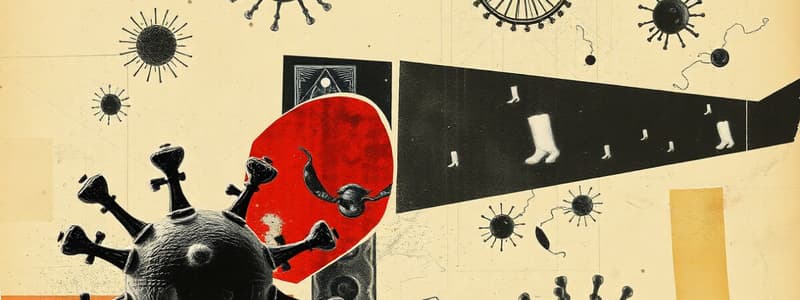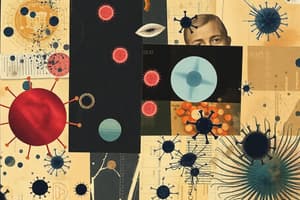Podcast
Questions and Answers
What is a primary function of the red pulp within the spleen?
What is a primary function of the red pulp within the spleen?
- Recycling red blood cells. (correct)
- Producing new lymphocytes.
- Filtering lymphatic fluid.
- Storing B cells.
Which of these best describes the lymphatic system's relationship with the circulatory system?
Which of these best describes the lymphatic system's relationship with the circulatory system?
- The lymphatic system is a component of the circulatory system.
- The systems are entirely opposing in function.
- They function independently of each other.
- The lymphatic system is parallel to the circulatory system. (correct)
What is a key characteristic of innate immunity in relation to pathogen recognition?
What is a key characteristic of innate immunity in relation to pathogen recognition?
- It adapts to novel pathogens over time.
- It is genetically encoded for a specific pathogen.
- It responds with highly variable reaction speed.
- It recognizes pathogens using a set response. (correct)
What feature of the lymphatic system results in its passive pumping system?
What feature of the lymphatic system results in its passive pumping system?
In a lymph node, where are the B cells primarily located?
In a lymph node, where are the B cells primarily located?
What is the main function of a lymph node?
What is the main function of a lymph node?
Which description correctly describes the origin of red and blue structures in the lymphatic system?
Which description correctly describes the origin of red and blue structures in the lymphatic system?
What general characteristic is shared amongst intracellular signalling pathways?
What general characteristic is shared amongst intracellular signalling pathways?
How do cells generally identify pathogens at their molecular level?
How do cells generally identify pathogens at their molecular level?
What describes the organization of the spleen?
What describes the organization of the spleen?
What is the primary function of cell surface receptors?
What is the primary function of cell surface receptors?
Which of the following best describes the role of signal transduction pathways?
Which of the following best describes the role of signal transduction pathways?
What is usually involved in the process of signal transduction pathways?
What is usually involved in the process of signal transduction pathways?
What is the unique characteristic of Pattern Recognition Receptors (PRRs)?
What is the unique characteristic of Pattern Recognition Receptors (PRRs)?
Where can Toll-like receptors (TLRs) be located within a cell?
Where can Toll-like receptors (TLRs) be located within a cell?
How do Toll-like receptors (TLRs) contribute to immune responses?
How do Toll-like receptors (TLRs) contribute to immune responses?
What family of pattern recognition receptors is typically found within the cytoplasm?
What family of pattern recognition receptors is typically found within the cytoplasm?
Which cell types express Pattern Recognition Receptors (PRRs)?
Which cell types express Pattern Recognition Receptors (PRRs)?
What is the significance of germline encoding for the specificity of Pattern Recognition Receptors (PRRs)?
What is the significance of germline encoding for the specificity of Pattern Recognition Receptors (PRRs)?
A fruit fly with a deficient toll gene is shown to be unable to fight off a fungal infection. What does this observation imply about the toll gene's usual function?
A fruit fly with a deficient toll gene is shown to be unable to fight off a fungal infection. What does this observation imply about the toll gene's usual function?
Which of the following best describes the function of Pathogen-Associated Molecular Patterns (PAMPs)?
Which of the following best describes the function of Pathogen-Associated Molecular Patterns (PAMPs)?
What is the primary role of Pattern Recognition Receptors (PRRs) in the immune response?
What is the primary role of Pattern Recognition Receptors (PRRs) in the immune response?
How does the activation of Toll-like Receptor 4 (TLR4) typically contribute to the immune response?
How does the activation of Toll-like Receptor 4 (TLR4) typically contribute to the immune response?
What is the significance of Damage-Associated Molecular Patterns (DAMPs) in the immune response?
What is the significance of Damage-Associated Molecular Patterns (DAMPs) in the immune response?
A cell releases cytokines, which act on various cell populations, resulting in different outcomes. Which term best describes this?
A cell releases cytokines, which act on various cell populations, resulting in different outcomes. Which term best describes this?
What is the implication of a cell having a smaller $K_d$ for a particular cytokine?
What is the implication of a cell having a smaller $K_d$ for a particular cytokine?
What is the role of Janus Kinases (JAKs) in Interleukin-2 (IL-2) signaling?
What is the role of Janus Kinases (JAKs) in Interleukin-2 (IL-2) signaling?
What is the primary function of the signal transduction of activation of transcription (STAT) following JAK phosphorylation?
What is the primary function of the signal transduction of activation of transcription (STAT) following JAK phosphorylation?
If a cell is exposed to a cytokine that induces cell movement, which of these cellular responses is being activated?
If a cell is exposed to a cytokine that induces cell movement, which of these cellular responses is being activated?
What does the term 'redundancy' mean in the context of cytokine action?
What does the term 'redundancy' mean in the context of cytokine action?
How do recipient cells prevent overstimulation by cytokines?
How do recipient cells prevent overstimulation by cytokines?
According to the content, which of the following is true regarding cytokine receptors?
According to the content, which of the following is true regarding cytokine receptors?
What cellular response is triggered when tumor necrosis factor (TNF) acts on a cell?
What cellular response is triggered when tumor necrosis factor (TNF) acts on a cell?
Which of the following best describes how cascade induction occurs within the context of cytokine action?
Which of the following best describes how cascade induction occurs within the context of cytokine action?
How do cytokines facilitate communication within the immune system?
How do cytokines facilitate communication within the immune system?
Flashcards
Innate Immunity
Innate Immunity
The innate immune system is the body's first line of defense against pathogens.
Human Lymphatic System
Human Lymphatic System
The lymphatic system is a network of vessels, tissues, and organs that help to protect the body from infection.
Structure of a Lymph Node
Structure of a Lymph Node
Lymph nodes are bean-shaped organs that are located throughout the body and filter lymph fluid.
Structure of the Spleen
Structure of the Spleen
Signup and view all the flashcards
Pathogen Recognition Detection
Pathogen Recognition Detection
Signup and view all the flashcards
Intracellular Signalling Pathways
Intracellular Signalling Pathways
Signup and view all the flashcards
Innate Immunity Response Speed
Innate Immunity Response Speed
Signup and view all the flashcards
Signal Transduction Receptors
Signal Transduction Receptors
Signup and view all the flashcards
Diversity of Signalling Pathways
Diversity of Signalling Pathways
Signup and view all the flashcards
Protein Cascades in Signaling
Protein Cascades in Signaling
Signup and view all the flashcards
Receptors
Receptors
Signup and view all the flashcards
Cell Surface Receptors
Cell Surface Receptors
Signup and view all the flashcards
Signal Transduction Pathway
Signal Transduction Pathway
Signup and view all the flashcards
Pattern Recognition Receptors (PRRs)
Pattern Recognition Receptors (PRRs)
Signup and view all the flashcards
Toll-Like Receptors (TLRs)
Toll-Like Receptors (TLRs)
Signup and view all the flashcards
Toll-Like Receptors (TLRs)
Toll-Like Receptors (TLRs)
Signup and view all the flashcards
Nucleotide Oligomerization Domain (NOD)-Like Receptors (NLRs)
Nucleotide Oligomerization Domain (NOD)-Like Receptors (NLRs)
Signup and view all the flashcards
C-type Lectin Receptors (CLRs)
C-type Lectin Receptors (CLRs)
Signup and view all the flashcards
Phagocytosis
Phagocytosis
Signup and view all the flashcards
Immunity
Immunity
Signup and view all the flashcards
What are PAMPs?
What are PAMPs?
Signup and view all the flashcards
What are PRRs?
What are PRRs?
Signup and view all the flashcards
What are TLRs?
What are TLRs?
Signup and view all the flashcards
What do TLRs do?
What do TLRs do?
Signup and view all the flashcards
What is phagocytosis?
What is phagocytosis?
Signup and view all the flashcards
What are DAMPs?
What are DAMPs?
Signup and view all the flashcards
What do TLRs recognize?
What do TLRs recognize?
Signup and view all the flashcards
What are cytokines?
What are cytokines?
Signup and view all the flashcards
What is pleiotropy of cytokines?
What is pleiotropy of cytokines?
Signup and view all the flashcards
What is redundancy of cytokines?
What is redundancy of cytokines?
Signup and view all the flashcards
What is cascade induction of cytokines?
What is cascade induction of cytokines?
Signup and view all the flashcards
What are receptors?
What are receptors?
Signup and view all the flashcards
What is IL-2?
What is IL-2?
Signup and view all the flashcards
What is the JAK-STAT pathway?
What is the JAK-STAT pathway?
Signup and view all the flashcards
What are the effects of cytokine signaling?
What are the effects of cytokine signaling?
Signup and view all the flashcards
Study Notes
Innate Immunity
- The lymphatic system parallels the circulatory system, but it has a passive pumping system (movement)
- Lymph nodes are highly organized and contain T cells, B cells, and primary and secondary organs.
- The spleen's function is recycling red blood cells, organized into red pulp, white pulp, and follicle regions.
Pathogen Recognition and Detection
- Innate immune responses are rapid and the same each time
- Pattern Recognition Receptors (PRRs) are encoded into the genome.
- Cells sense pathogens using cell surface receptors and phagocytosis.
Intracellular Signaling Pathways
- All signal transduction pathways have receptors that recognize signal molecules.
- Receptors bind to signal molecules, transmitting signals along a transduction pathway.
Pattern Recognition Receptors (PRRs)
- PRRs are expressed on various cell types
- They recognize conserved, invariant pathogen regions and damage/infection signals.
- They are germline encoded, thus specificities are already determined.
- They are critical for initiating immune responses.
- PRRs identify pathogens from Bacteria, Viruses, Parasites and Yeast (ex flagellum).
DAMPS (Damage-Associated Molecular Patterns)
- Released after cellular damage, identified by receptors.
- Trigger cellular damage signals and immune responses
4 Families of PRRs
- Toll-like receptors (TLRs)
- C-type lectin receptors (CLRs)
- Nucleotide-oligomerization domain-like receptors (NLRs)
- RIG-I-like receptors (RLRs)
TLRS & PAMPS (Pathogen-Associated Molecular Patterns)
- TLRs recognize a variety of PAMPS.
- TLR4 recognizes Gram-negative bacteria (lipopolysaccharide).
- These systems signal to the immune system early warning signals to activate and direct cells towards the pathogen.
Activation of Cellular Responses
- Splenic follicle region is a B-cell zone, part of the spleen.
- Spleen marginal zone contains part of the spleen.
- T cells and B cells reside in lymphoid tissues and organs.
- TLRs can recognize external and internal pathogens.
Cytokine Families
- Cytokines are "messages" (proteins) for communication among immune cells.
- Different cytokines and their receptors lead to inflammation and other effects.
- Pleiotropy (multiple actions) and redundancy (same effect from multiple cytokines).
Interleukin-2 Signaling Pathway
- IL-2 is found in many cells, including B cells and T cells.
- IL2 initiates cell division, crucial for immune responses.
- The pathway involves kinases (JAK) and signal transduction and activation of transcription factors (STAT).
- Higher affinity receptors respond more strongly to ligands (for instance IL2).
Extracellular Signaling: Cytokines
- Cytokines mediate cell movement (chemokines)
- Cytokines can act on a variety of cells, leading to pleiotropic results and even cascade inductions.
- Cells need specific receptors to respond to cytokines.
PRRs and Phagocytosis
- PRRs initiate phagocytosis in dendritic cells and macrophages for immune response.
- Phagocytosis occurs when PRRs bind to pathogens.
Receptors
- Receptors can be monomeric, dimeric, or multimeric.
- Various different Receptor types exist, and each has a different effect.
Cytokines Modes of Action
- Same cytokine can have different effects on different cells (Pleiotropy).
- Different cytokines can have similar effects (Redundancy).
Studying That Suits You
Use AI to generate personalized quizzes and flashcards to suit your learning preferences.




